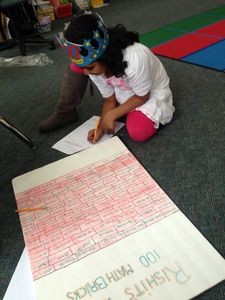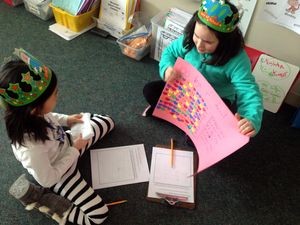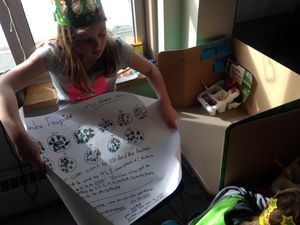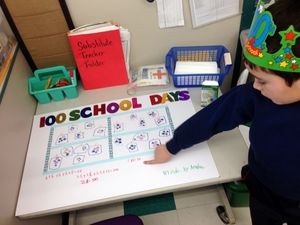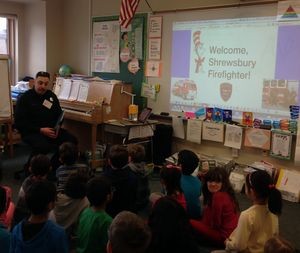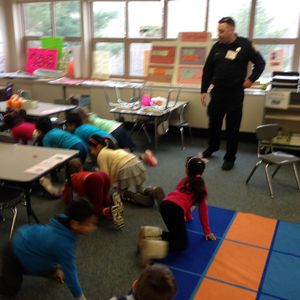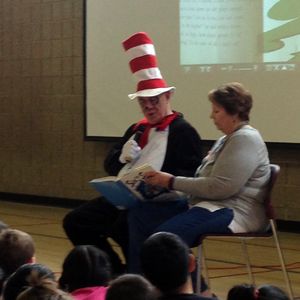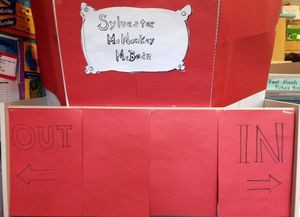Posted by kavery508 | Posted in Uncategorized | Posted on March 7, 2016
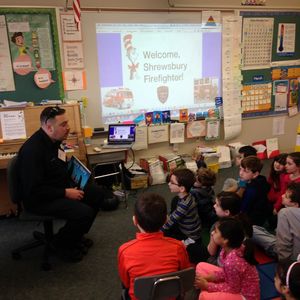 What a blast we had on Read Across America Day! Students in our class were treated to a visit from Shrewsbury firefighter Mike Guarino. Mr. Guarino read the book Dory Story by local author Jerry Pallotta, modeling for us the importance of interest when choosing books as readers. Mr. Guarino also engaged students with his work as a firefighter and gave us a lesson in fire safety, too! A big thanks to him for sharing his time and expertise.
What a blast we had on Read Across America Day! Students in our class were treated to a visit from Shrewsbury firefighter Mike Guarino. Mr. Guarino read the book Dory Story by local author Jerry Pallotta, modeling for us the importance of interest when choosing books as readers. Mr. Guarino also engaged students with his work as a firefighter and gave us a lesson in fire safety, too! A big thanks to him for sharing his time and expertise.
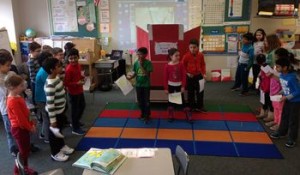 With a focus on Changing your voice to match the character as part of reading fluency, students took part in a reader’s theater production of Dr. Seuss’ The Sneetches. They did an excellent job bringing the dialogue to life in ways that show they understood the text. Fun! We ended the day with a celebration of reading at our School Meeting in the gym, during which time the Martel class shared favorite books and author’s messages, and even the Cat in the Hat made an appearance to read to us (Mr. Martel)!
With a focus on Changing your voice to match the character as part of reading fluency, students took part in a reader’s theater production of Dr. Seuss’ The Sneetches. They did an excellent job bringing the dialogue to life in ways that show they understood the text. Fun! We ended the day with a celebration of reading at our School Meeting in the gym, during which time the Martel class shared favorite books and author’s messages, and even the Cat in the Hat made an appearance to read to us (Mr. Martel)!
 Thank you for keeping our classroom stocked with health items this winter. We are currently in need of boxes of Kleenex (lots!) to get us through the rest of winter and through the spring. Please send in a couple of boxes when you can, and thanks!
Thank you for keeping our classroom stocked with health items this winter. We are currently in need of boxes of Kleenex (lots!) to get us through the rest of winter and through the spring. Please send in a couple of boxes when you can, and thanks!
 Our CAFE reading work focuses on the Comprehension strategy Determining Importance (DI). When reading text, especially informative text, there is a Main Idea and supporting details. Learning to recognize interesting details and differentiate them from important information is key to good understanding. Think about how we read a magazine article as adults. We look at the title and headings, and as we read we are always thinking about how the information relates to the topic. This helps us to disregard unimportant facts so we can retain essential ideas. To try this with your child at home, go to http://www.timeforkids.com/news. Choose an article to read together. After each section, talk about the interesting ideas and then decide on one main idea for each (often the headings are big clues). What information was important, and what was merely interesting?
Our CAFE reading work focuses on the Comprehension strategy Determining Importance (DI). When reading text, especially informative text, there is a Main Idea and supporting details. Learning to recognize interesting details and differentiate them from important information is key to good understanding. Think about how we read a magazine article as adults. We look at the title and headings, and as we read we are always thinking about how the information relates to the topic. This helps us to disregard unimportant facts so we can retain essential ideas. To try this with your child at home, go to http://www.timeforkids.com/news. Choose an article to read together. After each section, talk about the interesting ideas and then decide on one main idea for each (often the headings are big clues). What information was important, and what was merely interesting?
As a way to make DI meaningful for kids, they have been analyzing their opinion writing pieces on famous Americans, highlighting key words and phrases that are most important about their subjects. Media Specialist Christy Minton returns week to create wordsplashes with students using their results at the website Wordle.net. Cool!
 As the trimester ends, students will apply what they’ve learned about Informative Writing in a district-wide writing assessment this week. Their work has been phenomenal and they’re well-prepared!
As the trimester ends, students will apply what they’ve learned about Informative Writing in a district-wide writing assessment this week. Their work has been phenomenal and they’re well-prepared!
 The focus of this week’s math is estimating by rounding up/down and using estimation as a way to check the reasonableness of sums/differences. These are VERY important skills that require students to develop and apply number sense as they think critically about math. For a detailed and illustrated explanation, see the MIF Student Book 2B, pp. 28-35 (follow the link in the Parent Resources section of this blog and enter your PowerSchool credentials).
The focus of this week’s math is estimating by rounding up/down and using estimation as a way to check the reasonableness of sums/differences. These are VERY important skills that require students to develop and apply number sense as they think critically about math. For a detailed and illustrated explanation, see the MIF Student Book 2B, pp. 28-35 (follow the link in the Parent Resources section of this blog and enter your PowerSchool credentials).
At first, students just need to learn and practice the basic skill of rounding to the nearest 10. Next comes the smart stuff. To check that a sum/difference is reasonable, they will learn to use estimates (sometimes called Ballpark Estimates). Take this example: When solving 67 + 44, I can estimate the sum as 110 (67 rounds up to 70, plus 44 which rounds down to 40). My actual answer therefore needs to be close to 110 (less than a difference of 5). If I get an answer of 111, my estimate shows that my answer is reasonable and I likely have it correct. However if my answer is, say, 121 then I better check my work because that answer is too large to be correct. The beauty of using estimates is that they push kids to think of the numbers involved by rounding them into 10s and 100s, which they can ‘hold in their heads’ much easier than numbers like 67 and 44. This week’s homework is all about estimating; contact me if I can clarify!
 In Social Studies this week we will learn about in-between directions (NE, SE, NW, SW) and apply this skill to solving problems and finding places on local, national, and world maps. We often apply skills using a trivia game in which I or the students make up questions having to do with one of the maps mentioned that require students to practice the ability to use map features (map key, symbols, country borders, directions, and more). I encourage you to do the same at home. Making up questions helps to stretch your child’s knowledge and understanding of the subject. Good places for online maps are National Geographic and Google Earth.
In Social Studies this week we will learn about in-between directions (NE, SE, NW, SW) and apply this skill to solving problems and finding places on local, national, and world maps. We often apply skills using a trivia game in which I or the students make up questions having to do with one of the maps mentioned that require students to practice the ability to use map features (map key, symbols, country borders, directions, and more). I encourage you to do the same at home. Making up questions helps to stretch your child’s knowledge and understanding of the subject. Good places for online maps are National Geographic and Google Earth.
Putting map skills to the test, students will be devising questions in pairs and engaging in some friendly competition with students from our neighbors, the Young classroom at the end of the week!
Here are some more photos from Read Across America Day, along with the last of our 100 Day projects:

